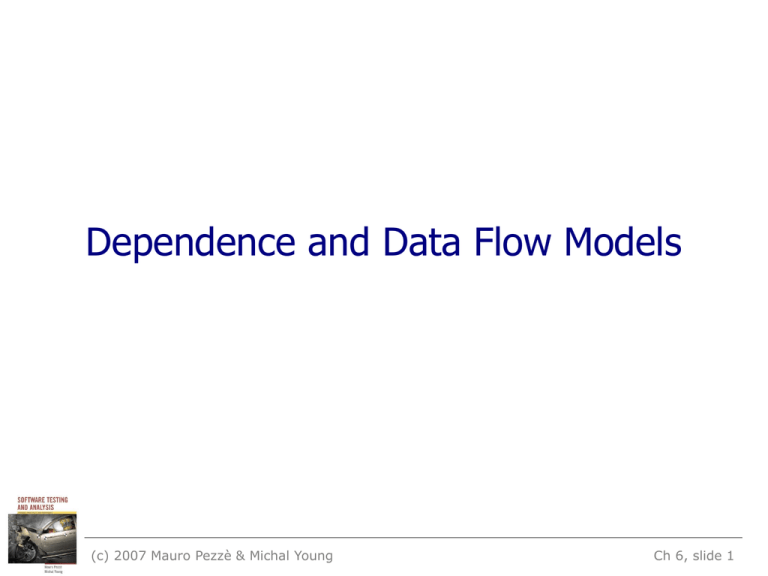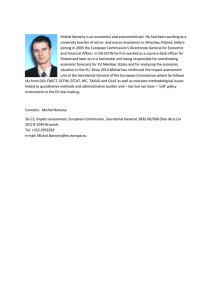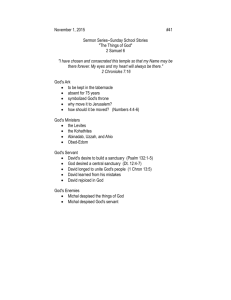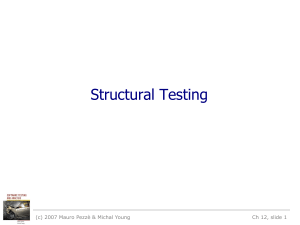Software Test and Analysis in a Nutshell
advertisement

Dependence and Data Flow Models
(c) 2007 Mauro Pezzè & Michal Young
Ch 6, slide 1
Why Data Flow Models?
• Models from Chapter 5 emphasized control
• Control flow graph, call graph, finite state machines
• We also need to reason about dependence
• Where does this value of x come from?
• What would be affected by changing this?
• ...
• Many program analyses and test design
techniques use data flow information
– Often in combination with control flow
• Example: “Taint” analysis to prevent SQL injection attacks
• Example: Dataflow test criteria (Ch.13)
(c) 2007 Mauro Pezzè & Michal Young
Ch 6, slide 2
Learning objectives
• Understand basics of data-flow models and the
related concepts (def-use pairs, dominators…)
• Understand some analyses that can be
performed with the data-flow model of a
program
– The data flow analyses to build models
– Analyses that use the data flow models
• Understand basic trade-offs in modeling data
flow
– variations and limitations of data-flow models and
analyses, differing in precision and cost
(c) 2007 Mauro Pezzè & Michal Young
Ch 6, slide 3
Def-Use Pairs (1)
• A def-use (du) pair associates a point in a program
where a value is produced with a point where it is used
• Definition: where a variable gets a value
–
–
–
–
Variable declaration (often the special value “uninitialized”)
Variable initialization
Assignment
Values received by a parameter
• Use: extraction of a value from a variable
–
–
–
–
Expressions
Conditional statements
Parameter passing
Returns
(c) 2007 Mauro Pezzè & Michal Young
Ch 6, slide 4
Def-Use Pairs
...
if (...) {
x = ... ;
...
}
y = ... + x + ... ;
Def-Use
path
...
if (...) {
Definition:
x gets a
value
x = ...
...
Use: the value
of x is
extracted
y = ... + x + ...
...
(c) 2007 Mauro Pezzè & Michal Young
Ch 6, slide 5
Def-Use Pairs (3)
/** Euclid's algorithm */
public class GCD
{
public int gcd(int x, int y) {
int tmp;
// A: def x, y, tmp
while (y != 0) { // B: use y
tmp = x % y; // C: def tmp; use x, y
x = y;
// D: def x; use y
y = tmp;
// E: def y; use tmp
}
return x;
// F: use x
}
Figure 6.2, page 79
(c) 2007 Mauro Pezzè & Michal Young
Ch 6, slide 6
Def-Use Pairs (3)
• A definition-clear path is a path along the CFG
from a definition to a use of the same variable
without* another definition of the variable
between
– If, instead, another definition is present on the
path, then the latter definition kills the former
• A def-use pair is formed if and only if there is a
definition-clear path between the definition
and the use
*There is an over-simplification
here, which we will repair later.
(c) 2007 Mauro Pezzè & Michal Young
Ch 6, slide 7
Definition-Clear or Killing
x = ... // A: def x
q = ...
x = y; // B: kill x, def x
z = ...
y = f(x); // C: use x
...
A
x = ...
Definition: x
gets a value
...
Path A..C is
not definition-clear
Path B..C is
definition-clear
(c) 2007 Mauro Pezzè & Michal Young
B
x=y
Definition: x gets
a new value, old
value is killed
...
C
y = f(x)
Use: the value
of x is
extracted
Ch 6, slide 8
(Direct) Data Dependence Graph
• A direct data dependence graph is:
– Nodes: as in the control flow graph (CFG)
– Edges: def-use (du) pairs, labelled with the variable name
Dependence
edges show this
x value could be
the unchanged
parameter or
could be set at
line D
(Figure 6.3, page 80)
(c) 2007 Mauro Pezzè & Michal Young
Ch 6, slide 9
Control dependence (1)
• Data dependence: Where did these values come from?
• Control dependence: Which statement controls whether
this statement executes?
– Nodes: as in the CFG
– Edges: unlabelled, from entry/branching points to controlled
blocks
(c) 2007 Mauro Pezzè & Michal Young
Ch 6, slide 10
Dominators
• Pre-dominators in a rooted, directed graph can be
used to make this intuitive notion of “controlling
decision” precise.
• Node M dominates node N if every path from the root
to N passes through M.
– A node will typically have many dominators, but except for the
root, there is a unique immediate dominator of node N which
is closest to N on any path from the root, and which is in turn
dominated by all the other dominators of N.
– Because each node (except the root) has a unique immediate
dominator, the immediate dominator relation forms a tree.
• Post-dominators: Calculated in the reverse of the
control flow graph, using a special “exit” node as the
root.
(c) 2007 Mauro Pezzè & Michal Young
Ch 6, slide 11
Dominators (example)
A
B
C
E
D
F
G
• A pre-dominates all nodes;
G post-dominates all
nodes
• F and G post-dominate E
• G is the immediate postdominator of B
– C does not post-dominate B
• B is the immediate predominator of G
– F does not pre-dominate G
(c) 2007 Mauro Pezzè & Michal Young
Ch 6, slide 12
Control dependence (2)
• We can use post-dominators to give a more precise
definition of control dependence:
– Consider again a node N that is reached on some but not all
execution paths.
– There must be some node C with the following property:
• C has at least two successors in the control flow graph (i.e., it
represents a control flow decision);
• C is not post-dominated by N
• there is a successor of C in the control flow graph that is postdominated by N.
– When these conditions are true, we say node N is controldependent on node C.
• Intuitively: C was the last decision that controlled whether N
executed
(c) 2007 Mauro Pezzè & Michal Young
Ch 6, slide 13
Control Dependence
A
Execution of F is
not inevitable at B
B
C
E
D
F
G
Execution of F is
inevitable at E
F is control-dependent on B,
the last point at which its
execution was not inevitable
(c) 2007 Mauro Pezzè & Michal Young
Ch 6, slide 14
Data Flow Analysis
Computing data flow information
(c) 2007 Mauro Pezzè & Michal Young
Ch 6, slide 15
Calculating def-use pairs
• Definition-use pairs can be defined in terms of paths in the
program control flow graph:
– There is an association (d,u) between a definition of variable v at d
and a use of variable v at u iff
• there is at least one control flow path from d to u
• with no intervening definition of v.
– vd reaches u (vd is a reaching definition at u).
– If a control flow path passes through another definition e of the same
variable v, ve kills vd at that point.
• Even if we consider only loop-free paths, the number of paths in a
graph can be exponentially larger than the number of nodes and
edges.
• Practical algorithms therefore do not search every individual path.
Instead, they summarize the reaching definitions at a node over all
the paths reaching that node.
(c) 2007 Mauro Pezzè & Michal Young
Ch 6, slide 16
Exponential paths
(even without loops)
A
B
C
D
2 paths from A to B
4 from A to C
8 from A to D
E
F
G
V
Tracing each path is
not efficient, and we
can do much better.
16 from A to E
...
128 paths from A to V
(c) 2007 Mauro Pezzè & Michal Young
Ch 6, slide 17
DF Algorithm
• An efficient algorithm for computing reaching
definitions (and several other properties) is based on
the way reaching definitions at one node are related to
the reaching definitions at an adjacent node.
• Suppose we are calculating the reaching definitions of
node n, and there is an edge (p,n) from an immediate
predecessor node p.
– If the predecessor node p can assign a value to variable v, then
the definition vp reaches n. We say the definition vp is
generated at p.
– If a definition vp of variable v reaches a predecessor node p,
and if v is not redefined at that node (in which case we say the
vp is killed at that point), then the definition is propagated on
from p to n.
(c) 2007 Mauro Pezzè & Michal Young
Ch 6, slide 18
Equations of node E (y = tmp)
Calculate reaching
definitions at E in
terms of its
immediate
predecessor D
public class GCD {
public int gcd(int x,
int tmp;
while (y != 0) {
tmp = x % y;
x = y;
y = tmp;
}
return x;
}
int y) {
// A: def x, y, tmp
// B: use y
// C: def tmp; use x, y
// D: def x; use y
// E: def y; use tmp
// F: use x
Reach(E) = ReachOut(D)
ReachOut(E) = (Reach(E) \ {yA}) {yE}
(c) 2007 Mauro Pezzè & Michal Young
Ch 6, slide 19
Equations of node B (while (y != 0))
This line has two
predecessors:
Before the loop,
end of the loop
public class GCD {
public int gcd(int x,
int tmp;
while (y != 0) {
tmp = x % y;
x = y;
y = tmp;
}
return x;
}
int y) {
// A: def x, y, tmp
// B: use y
// C: def tmp; use x, y
// D: def x; use y
// E: def y; use tmp
// F: use x
• Reach(B) = ReachOut(A) ReachOut(E)
• ReachOut(A) = gen(A) = {xA, yA, tmpA}
• ReachOut(E) = (Reach(E) \ {yA}) {yE}
(c) 2007 Mauro Pezzè & Michal Young
Ch 6, slide 20
General equations for Reach analysis
Reach(n) =
ReachOut(m)
mpred(n)
ReachOut(n) = (Reach(n) \ kill (n)) gen(n)
gen(n) = { vn | v is defined or modified at n }
kill(n) = { vx | v is defined or modified at x, x≠n }
(c) 2007 Mauro Pezzè & Michal Young
Ch 6, slide 21
Avail equations
Avail (n) =
AvailOut(m)
mpred(n)
AvailOut(n) = (Avail (n) \ kill (n)) gen(n)
gen(n) = { exp | exp is computed at n }
kill(n) = { exp | exp has variables assigned at n }
(c) 2007 Mauro Pezzè & Michal Young
Ch 6, slide 22
Live variable equations
Live(n) =
LiveOut(m)
msucc(n)
LiveOut(n) = (Live(n) \ kill (n)) gen(n)
gen(n) = { v | v is used at n }
kill(n) = { v | v is modified at n }
(c) 2007 Mauro Pezzè & Michal Young
Ch 6, slide 23
Classification of analyses
• Forward/backward: a node’s set depends on that of its
predecessors/successors
• Any-path/all-path: a node’s set contains a value iff it is
coming from any/all of its inputs
Any-path ()
All-paths ()
Forward (pred)
Reach
Avail
Backward (succ)
Live
“inevitable”
(c) 2007 Mauro Pezzè & Michal Young
Ch 6, slide 24
Iterative Solution of Dataflow Equations
• Initialize values (first estimate of answer)
– For “any path” problems, first guess is “nothing”
(empty set) at each node
– For “all paths” problems, first guess is “everything”
(set of all possible values = union of all “gen” sets)
• Repeat until nothing changes
– Pick some node and recalculate (new estimate)
This will converge on a “fixed point” solution
where every new calculation produces the
same value as the previous guess.
(c) 2007 Mauro Pezzè & Michal Young
Ch 6, slide 25
Worklist Algorithm for Data Flow
See figures 6.6, 6.7 on pages 84, 86 of Pezzè & Young
One way to iterate to a fixed point solution.
General idea:
• Initially all nodes are on the work list, and have default values
– Default for “any-path” problem is the empty set, default for “allpath” problem is the set of all possibilities (union of all gen sets)
• While the work list is not empty
– Pick any node n on work list; remove it from the list
– Apply the data flow equations for that node to get new values
– If the new value is changed (from the old value at that node), then
• Add successors (for forward analysis) or predecessors (for backward
analysis) on the work list
• Eventually the work list will be empty (because new computed
values = old values for each node) and the algorithm stops.
(c) 2007 Mauro Pezzè & Michal Young
Ch 6, slide 26
Cooking your own: From Execution to
Conservative Flow Analysis
• We can use the same data flow algorithms to
approximate other dynamic properties
– Gen set will be “facts that become true here”
– Kill set will be “facts that are no longer true here”
– Flow equations will describe propagation
• Example: Taintedness (in web form processing)
– “Taint”: a user-supplied value (e.g., from web
form) that has not been validated
– Gen: we get this value from an untrusted source
here
– Kill: we validated to make sure the value is proper
(c) 2007 Mauro Pezzè & Michal Young
Ch 6, slide 27
Cooking your own analysis (2)
• Flow equations must be
monotonic
– Initialize to the bottom
element of a lattice of
approximations
– Each new value that
changes must move up the
lattice
Monotonic: y > x implies f(y) ≥ f(x)
(where f is application of the flow
equations on values from successor
or predecessor nodes, and “>” is
movement up the lattice)
• Typically: Powerset
lattice
– Bottom is empty set, top is
universe
– Or empty at top for allpaths analysis
(c) 2007 Mauro Pezzè & Michal Young
Ch 6, slide 28
Data flow analysis with arrays and pointers
• Arrays and pointers introduce uncertainty:
Do different expressions access the same
storage?
– a[i] same as a[k] when i = k
– a[i] same as b[i] when a = b (aliasing)
• The uncertainty is accomodated depending to
the kind of analysis
– Any-path: gen sets should include all potential
aliases and kill set should include only what is
definitely modified
– All-path: vice versa
(c) 2007 Mauro Pezzè & Michal Young
Ch 6, slide 29
Scope of Data Flow Analysis
• Intraprocedural
– Within a single method or procedure
• as described so far
• Interprocedural
– Across several methods (and classes) or procedures
• Cost/Precision trade-offs for interprocedural
analysis are critical, and difficult
– context sensitivity
– flow-sensitivity
(c) 2007 Mauro Pezzè & Michal Young
Ch 6, slide 30
Context Sensitivity
foo() {
(call)
bar() {
sub() {
(call)
sub()
sub()
(return)
}
}
(return)
}
A context-sensitive (interprocedural) analysis
distinguishes sub() called from foo()
from sub() called from bar();
A context-insensitive (interprocedural) analysis
does not separate them, as if foo() could call sub()
and sub() could then return to bar()
(c) 2007 Mauro Pezzè & Michal Young
Ch 6, slide 31
Flow Sensitivity
• Reach, Avail, etc. were flow-sensitive,
intraprocedural analyses
– They considered ordering and control flow decisions
– Within a single procedure or method, this is (fairly)
cheap — O(n3) for n CFG nodes
• Many interprocedural flow analyses are flowinsensitive
– O(n3) would not be acceptable for all the statements
in a program!
• Though O(n3) on each individual procedure might be ok
– Often flow-insensitive analysis is good enough ...
consider type checking as an example
(c) 2007 Mauro Pezzè & Michal Young
Ch 6, slide 32
Summary
• Data flow models detect patterns on CFGs:
– Nodes initiating the pattern
– Nodes terminating it
– Nodes that may interrupt it
• Often, but not always, about flow of information
(dependence)
• Pros:
– Can be implemented by efficient iterative algorithms
– Widely applicable (not just for classic “data flow” properties)
• Limitations:
– Unable to distinguish feasible from infeasible paths
– Analyses spanning whole programs (e.g., alias analysis) must
trade off precision against computational cost
(c) 2007 Mauro Pezzè & Michal Young
Ch 6, slide 33


